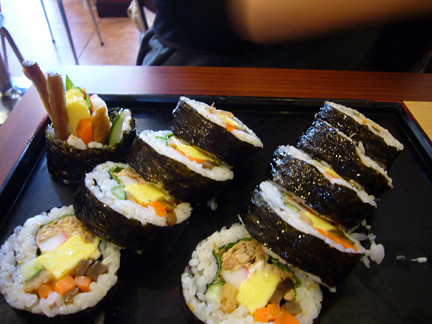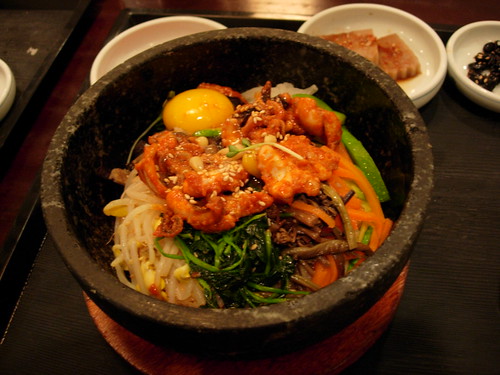Bibimbap (비빔밥)
A simple but popular dish, bibimbap is a bowl of hot rice served in a bowl topped with a variety of vegetables (cooked and raw) arranged on top. Vegetables can be seasonal, with toraji, bell flower roots, gosari, bracken, bean sprouts, and spinach often served. Other ingredients can include chestnuts, jujubes, ginseng, and a small amount of seafood or meat. An egg may be also served on the top. Most restaurants prepare the dish with a big scoop of gochujang and red pepper paste placed with the vegetables. (Ask for it to be placed on the side if you do not like the taste much.) This dish comes in two ways: a large bowl with rice on the bottom and the other ingredients placed on top, or just the ingredients in the bowl and a separate bowl of rice. Mix all the ingredients together then use your spoon to eat. A bowl of light soup is also served.
 Gimbap (김밥)
Gimbap (김밥)Gimbap (usually spelled Kimbap) is Korea's most popular and nutritious convenience meal. You can find it sold everywhere: picnics, schoolchildren's lunch boxes, street venders, and convenience stores. A layer of cooked rice is spread over a square piece of gim (dried laver). Various ingredients (including ham, sausage, spinach, cucumber, crab meat, carrots, and radishes) are thinly sliced and placed on top. The laver is rolled into a tube, sliced into sliced pieces, and seasoned with sesame seeds. The idea was borrowed from the Japanese during the colonial period, but Korean Gimbap is slightly different.
How to eat: Each roll is sliced into bite-sized pieces. Eat one at a time with chopsticks. If you eat at a street vender, sometimes you have to use a tooth pick instead of chopsticks.

Dolsot Bibimbap(돌솥비빔밥)
Similar ti Bibimbap, Dolsot Bibimbap's ingerdients include rice and various vegetables (sometimes with meat). While regular Bibimbap is usually served in a cool bowl, Dolsot Bibimbap comes in a hot crock. Also, it usually includes more ingredients.
To eat, mix the ingredients together then eat with a spoon. After eating, poor some hot water into the crock to soften the rice that sticks to the side. Scrape off this rice (called nudungji) and eat it as well.


No comments:
Post a Comment